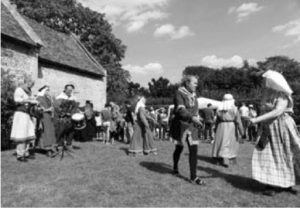For the 70 years after the death of Roger de Weston in 1447 the records of the Rectors of Willingham do not provide the same level of detail as for earlier Rectors. We know of John Sugden (1447), John Newhous (1472), and Robert Williamson (1475), but we know little of them as individuals.
This is particularly disappointing as a tremendous amount was happening between 1450 and 1520 to Saint Matthew’s Church in Willingham (as it was still known).
Reign of Henry Vl 1422-1471
Edward lV 1461-1483
Richard lll 1483-1485
Additions to the Church
Two internal oak screens were added to form the Vestry and the de Bruyne Chapel (now the Lady Chapel). John de Bruyne (later Bourn) was Lord of the smaller of the two Manors in Willingham, located off the High Street opposite the Post Office (later to be known as Bourneys Manor). His will of 1475 contains a bequest for ’a small bell to harmonise with the other three bells already hanging in the church tower’. So we know that Willingham bells, now increased to six, have been ringing for well over 540 years. A large rood screen was also added filling the whole space under the chancel arch. It is no longer there now, but there still remains intact the small spiral staircase of 12 very well worn steps up to it. These additions were very typical of late medieval Catholicism.
The wallpainting of the great ‘Doom Scene’ was also completed around this time on the chancel arch itself. It was meant to dramatise the difference between heaven and hell on Judgement Day. It certainly succeeds. The righteous are shown as naked figures (apparently all women) rising to paradise, while on the right more naked female figures are being dragged down through flames into the jaws of hell.
The Bishop of Ely. Lord of the Manor
It is difficult now to appreciate the sheer power of the Church on day to day living at this time. The Bishop of Ely was the landlord, employer, and law enforcer (through his manorial court), as well as being the local spiritual leader of a very powerful Catholic Church. He was incredibly wealthy. Bishops received a similar salary to earls, and Ely was high up the salary list of 17 diocesan bishops, with an income of £2500 pa, an enormous amount then. Meanwhile most villagers would typically work three days each week on the lord’s land, in return for which they could work the rest of the week on their own allocated piece of land. For this they then paid rent, frequently ‘in kind’ with some of their own produce. But not on Sundays. Church attendance was compulsory, where the villagers would be standing (not sitting) through the Latin ritual service.
Feasts and Fairs
However there were compensations, not least the Feast Days and Fairs to look forward to for eating, drinking, dancing, trading, shopping and making music. Three annual Fairs had grown in Cambridge as well as a weekly market, and were becoming very large indeed. Midsummer Fair lasted several days each June, followed by Garlic Fair in August, but the largest by far was Stourbridge Fair each September. It was to become known as the largest Fair in Europe with many hundreds of stalls. St. Ives had been granted a charter for a weekly market in 1110 and had also developed a large annual Easter Fair.
Next time: Willingham during the Reformatio
Stourbridge Fair (re-creation)

